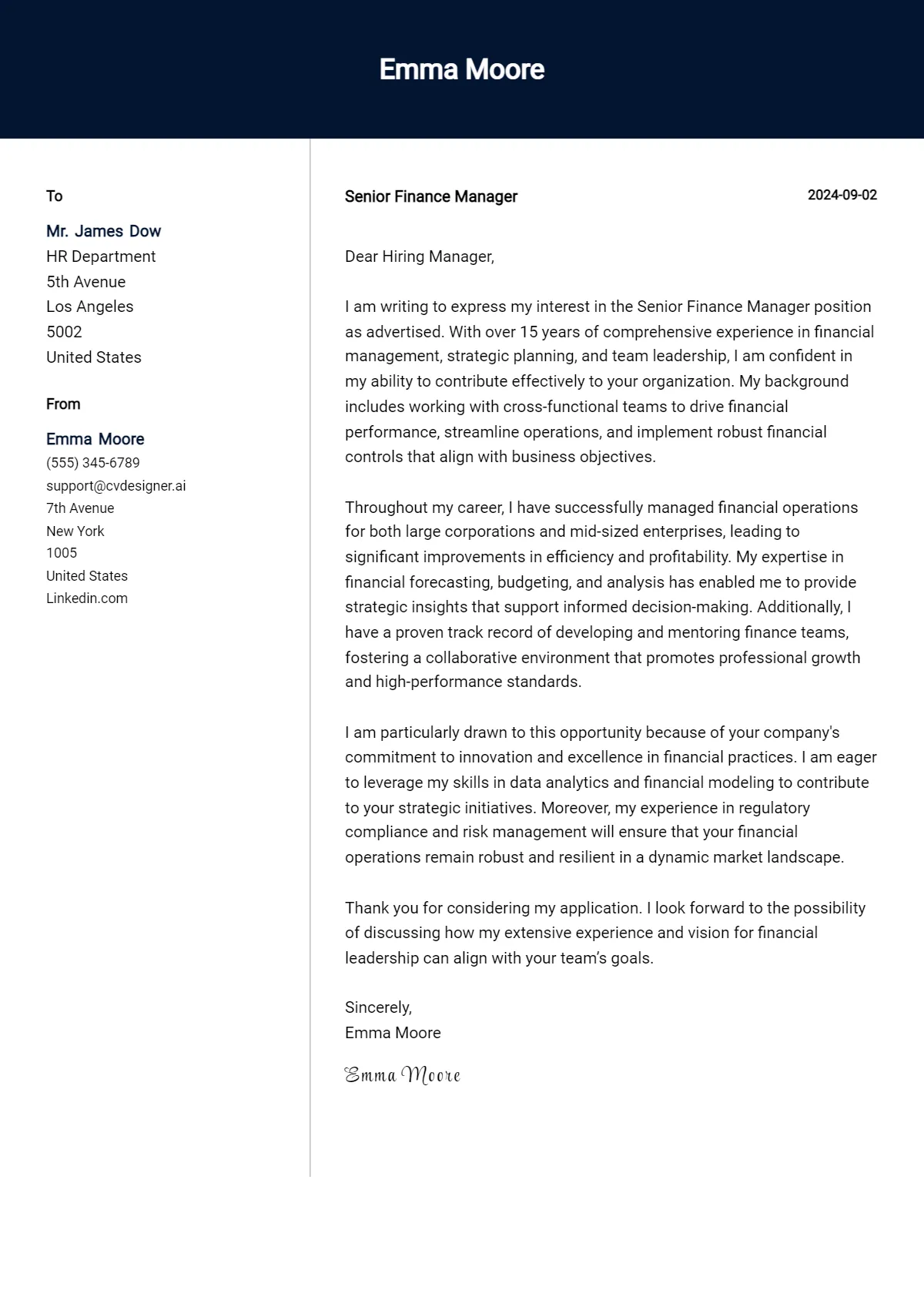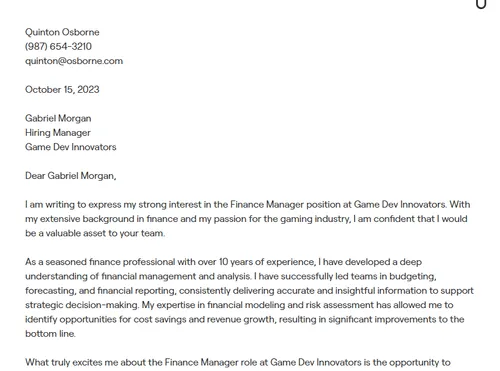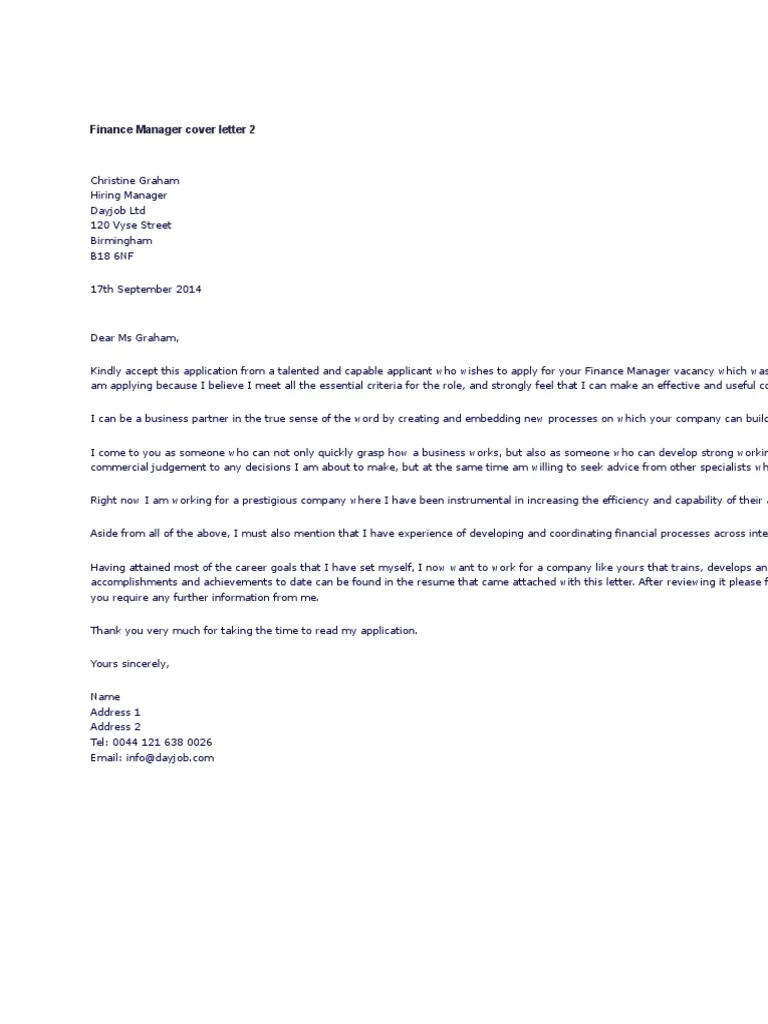What is a Finance Manager Cover Letter?
A Finance Manager cover letter is a crucial document that accompanies your resume when applying for finance manager positions. It serves as your first introduction to a potential employer, providing an opportunity to showcase your skills, experience, and personality in a way that a resume alone cannot. It’s your chance to articulate your career goals, highlight your qualifications, and demonstrate why you are the ideal candidate for the role. A well-crafted cover letter grabs the hiring manager’s attention and motivates them to delve deeper into your qualifications as presented in your resume. It’s more than just a formality; it’s a strategic tool in the job application process, setting the tone for your candidacy and increasing your chances of securing an interview. The best cover letters for finance managers clearly communicate their value proposition, demonstrating how their expertise aligns with the specific needs of the company. Understanding the purpose and importance of this document is the first step in creating a compelling application that stands out from the competition.
Key Components to Include in Your Cover Letter
Creating a successful finance manager cover letter involves incorporating several key components. Begin with a professional header that includes your contact information, the date, and the hiring manager’s name and title, if available. The opening paragraph should immediately grab the reader’s attention, stating the specific position you are applying for and expressing your enthusiasm for the opportunity. In the body of the letter, highlight your relevant skills and experience, providing specific examples that demonstrate your accomplishments. Quantify your achievements whenever possible, using numbers and metrics to showcase your impact on previous organizations. Mention any specific software or financial tools you’re proficient in, like SAP, Oracle, or financial modeling software. Be sure to address the company’s needs, explaining how your skills and experience align with their requirements. The closing paragraph should reiterate your interest, express your gratitude for their consideration, and include a call to action, such as inviting them to contact you for an interview. Always proofread carefully for any errors in grammar and punctuation before submitting your application.
Highlighting Relevant Skills and Experience

The most effective cover letters for finance managers emphasize the skills and experience most relevant to the target position. Start by reviewing the job description and identifying the key requirements. Then, choose the skills and experiences from your background that directly match those requirements. Quantify your accomplishments using numbers and data to showcase your impact. For example, instead of simply stating that you “managed budgets,” state that you “managed budgets totaling $10 million, resulting in a 5% reduction in operational costs.” Highlight specific software proficiency, such as experience with financial modeling software, ERP systems (like SAP or Oracle), or data analysis tools. Showcase your understanding of financial reporting, budgeting, forecasting, and financial analysis. Provide concise examples of how you have successfully managed financial operations, improved processes, or helped organizations achieve their financial goals. Tailoring your cover letter to the specific job description increases your chances of getting noticed by the hiring manager.
Tailoring Your Cover Letter to the Job Description
One of the most important steps in crafting a compelling cover letter is tailoring it to the specific job description. Begin by carefully reading the job posting, identifying the key responsibilities, required skills, and preferred qualifications. Then, customize your cover letter to address these specific needs. Highlight how your skills and experience align with the requirements outlined in the job description, using keywords from the posting. If the job description emphasizes experience with a particular software program, be sure to mention your proficiency with that software and provide examples of how you’ve used it in the past. Similarly, if the posting highlights the need for strong leadership skills, provide examples of your leadership experiences and accomplishments. By demonstrating a clear understanding of the job requirements and how you meet them, you increase your chances of capturing the hiring manager’s attention and securing an interview. Avoid sending a generic cover letter; instead, show that you’ve taken the time to understand the specific needs of the company and the role.
Proofreading and Formatting Your Cover Letter
Proofreading and formatting your cover letter is an essential step that can significantly impact the first impression you make on a potential employer. Ensure that your cover letter is free of grammatical errors, spelling mistakes, and typos. Carefully review the document for clarity, conciseness, and proper sentence structure. Use a professional and easy-to-read font, such as Times New Roman, Arial, or Calibri, and maintain a consistent font size (typically 11 or 12 points) throughout the document. Use clear headings and bullet points to break up large blocks of text and make your letter easier to read. Pay attention to the formatting, ensuring that your margins are consistent and that the document is well-organized. Consider having a friend or colleague review your cover letter to catch any errors you may have missed. A well-formatted and error-free cover letter demonstrates your attention to detail and professionalism, increasing your chances of making a positive impression. The image of a finance manager reviewing a document is always great to showcase.
Follow Up and Submission Best Practices

Once you’ve submitted your cover letter and resume, it’s important to follow up and adhere to best practices. Always follow the instructions provided in the job posting regarding how to submit your application. Some companies prefer online submissions, while others may request email attachments or physical copies. After submitting your application, wait for a reasonable period (usually one to two weeks) before following up with the hiring manager or the HR department. Send a brief, polite email expressing your continued interest in the position and inquiring about the status of your application. If you have the hiring manager’s contact information, you can address the email directly to them; otherwise, address it to the HR department. When following up, be professional and concise, reiterating your interest and highlighting your key qualifications. Be prepared to answer any questions the hiring manager may have about your application. This proactive approach can help demonstrate your enthusiasm and increase your chances of getting noticed. If you don’t hear back after a second follow-up, it’s generally acceptable to assume that your application was not successful and to move on to other opportunities.
